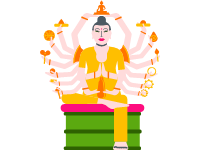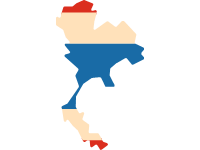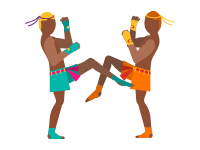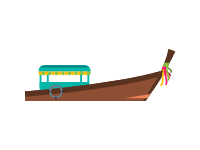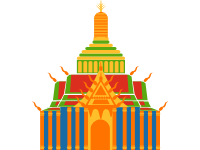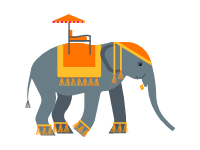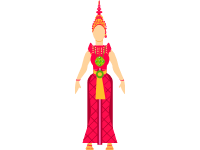| |
he Golden Buddha, officially titled Phra Phuttha Maha Suwanna Patimakon, commonly known in Thai as Phra Sukhothai Traimit (Thai: พระสุโขทัยไตรมิตร), is a gold Maravijaya Attitude seated Buddharupa statue, with a weight of 5.5 tonnes (5,500 kilograms). It is located in the temple of Wat Traimit, Bangkok, Thailand. At one point in its history the statue was covered with a layer of stucco and coloured glass to conceal its true value, and it remained in this condition for almost 200 years, ending up as what was then a pagoda of minor significance. During relocation of the statue in 1955, the plaster was chipped off and the gold revealed. The statue is 3 metres (9.8 ft) tall and weighs 5.5 tonnes (5.4 long tons; 6.1 short tons). (According to another account, the statue measures 3.91 meters from base to top, and 3.10 meters across the lap from knee to knee.) It can be disassembled into nine pieces. The statue was housed in a wat in Ayutthaya until the mid 19th century, and its provenance from Ayutthaya excludes the possibility of it having been made after about 1750.
At US$1,400 per troy ounce, the gold in the statue (18 karat) is estimated to be worth 250 million dollars. The body of the statue is 40% pure, the volume from the chin to the forehead is 80% pure, and the hair and the topknot, weighing 45 kg, are 99% pure gold.
The Buddha is represented in the traditional pose of Bhumisparsha Mudra (touching the earth with the right hand to witness Shakyamuni Buddha's enlightenment at Bodh Gaya). The original statues of Sukhothai sit on a common pedestal form. The flame that crowns the ushnisha is an innovation of Sukhothai that symbolises the splendour of spiritual energy. The line of the hairdressing forms a 'V' shape in the root of the hairs, underlined by the elegant curve of the eyebrows that join above the aquiline nose, all according to the prescribed rules. The three wrinkles in the neck and the much elongated ear lobes, signs of his former status of prince, also form part of the code, as do the wide shoulders and the chest inflated.
| |
at Arun Ratchawararam Ratchawaramahawihan or Wat Arun is a Buddhist temple (wat) in Bangkok Yai district of Bangkok, Thailand, on the Thonburi west bank of the Chao Phraya River. The temple derives its name from the Hindu god Aruna, often personified as the radiations of the rising sun. Wat Arun is among the best known of Thailand's landmarks. The first light of the morning reflects off the surface of the temple with pearly iridescence. Although the temple had existed since at least the seventeenth century, its distinctive prang (spires) were built in the early nineteenth century during the reign of King Rama II. he main feature of Wat Arun is its central prang (Khmer-style tower), which is encrusted with colourful porcelain.This is interpreted as a stupa-like pagoda encrusted with coloured faience. The height is reported by different sources as between 66.8 m (219 ft) and 86 m (282 ft). The corners are surrounded by four smaller satellite prang. The prang are decorated by seashells and bits of porcelain, which had previously been used as ballast by boats coming to Bangkok from China.
The central prang is topped with a seven-pronged trident, referred to by many sources as the 'Trident of Shiva'. Around the base of the prang are various figures of ancient Chinese soldiers and animals. Over the second terrace are four statues of the Hindu god Indra riding on Erawan. In the Buddhist iconography, the central prang is considered to have three symbolic levels—base for Traiphum indicating all realms of existence, middle for Tavatimsa where all desires are gratified, and top denoting Devaphum indicating six heavens within seven realms of happiness. At the riverside are six pavilions (sala) in the Chinese style. The pavilions are made of green granite and contain landing bridges.
Next to the prang is the Ordination Hall with a Niramitr Buddha image supposedly designed by King Rama II. The front entrance of the Ordination Hall has a roof with a central spire, decorated in coloured ceramic and stuccowork sheathed in coloured china. There are two demons, or temple guardian figures, in front. The murals were created during the reign of Rama V.
| |
Wat Phra Kaew, commonly known in English as the Temple of the Emerald Buddha and officially as Wat Phra Si Rattana Satsadaram, is regarded as the most sacred Buddhist temple in Thailand. The complex consists of a number of buildings within the precincts of the Grand Palace in the historical centre of Bangkok. It houses the statue of the Emerald Buddha, which is venerated as the country's palladium.
Construction of the temple began in 1783 under the orders of Rama I, the first king of the Chakri dynasty. Since then, each successive king has been personally involved in adding, restoring and embellishing the temple during their reigns as a way of making religious merit and glorifying the dynasty. Many important state and royal ceremonies are held within the temple each year, presided by the king in person and attended by government officials. This makes the temple the nation's preeminent place of worship and a national shrine for the monarchy and the state. Throughout the years, each king has donated sacred and valuable objects inside the temple, making it a treasury as well.
The temple complex comprises various buildings for specific religious purposes built in a variety of Thai architectural styles, while still adhering to the traditional principles of Thai religious architecture.
| |
Wat Suthat Thepwararam is a Buddhist temple in Bangkok, Thailand. It is a royal temple of the first grade, one of ten such temples in Bangkok (23 in Thailand). Construction was begun by King Rama I in 2350 BE (1807 CE). In the beginning time it was called 'Wat Maha Sutthawat' and located in the combretum grove. Further construction and decorations were carried out by King Rama II who helped carve the wooden doors, but the temple was not completed until the reign of King Rama III in 2390 BE (1847–1848 CE). This temple contains the Buddha image Phra Sri Sakyamuni which have been moved from Sukhothai Province. At the lower terrace of the base, there are 28 Chinese pagodas which symbolize the 28 Buddhas born on this earth. Wat Suthat also contains Phra Buddha Trilokache in the ubosot (ordination hall) and Phra Buddha Setthamuni in the Sala Kan Parian.
In 2005 CE, the temple was submitted to UNESCO for consideration as a future World Heritage Site.
|
|


